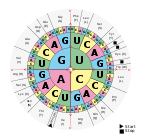Wikipedia:Today's featured list/March 19, 2021
A codon table can be used to translate a genetic code into a sequence of amino acids. The standard genetic code is traditionally represented as an RNA codon table, because when proteins are made in a cell by ribosomes, it is messenger RNA that directs protein biosynthesis. The mRNA sequence is determined by the sequence of genomic DNA. It can also be represented in a DNA codon table. The DNA codons in such tables occur on the sense DNA strand and are arranged in a 5′-to-3′ direction. Different tables with alternate codons are used depending on the source of the genetic code, such as from a cell nucleus, mitochondrion, plastid, or hydrogenosome. There are 64 different codons in the genetic code and the tables; most specify an amino acid. Three sequences, UAG, UGA, and UAA, known as stop codons, do not code for an amino acid but instead signal the release of the nascent polypeptide from the ribosome. (Full list...)

